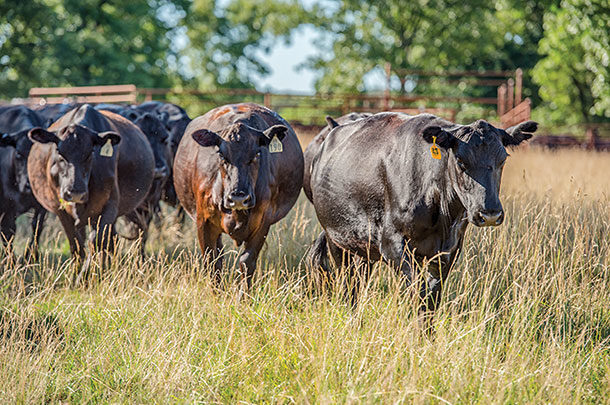Most of us are very familiar with the agronomic advantages of endophyte-infected tall fescue. In short, endophyte-infected tall fescue thrives through a variety of environmental challenges most grasses wouldn’t tolerate, including drought stress, overgrazing and insect pressure.From a cattle management standpoint, these benefits allow us to maintain stocking density and forage inventory, even during challenging conditions, with very minimal input cost compared to alternative forage crops.
However, the same endophyte fungus that allows fescue to thrive in our environment negatively impacts productivity of the species that graze it. To quantify these negative impacts, reductions in weight gain and pregnancy rates are estimated to cost the U.S. beef industry more than $600 million annually. In reality, we can’t just replace all the endophyte-infected fescue tomorrow, so learning to manage around it is key for today’s success.
1. General management
Good health and nutrition management is the best place to start when combating endophyte-infected fescue. Internal and external parasite control and vaccination programs are essential to maximizing production in all environment settings. Monitor body condition regularly to maintain cows in appropriate condition. Vitamin and trace mineral nutrition is essential for supporting immunity and reproduction, which can be suppressed by fescue toxicosis. A good fescue management plan starts by reducing common stressors present in your operation. Once we apply good general management, we can then move on to managing fescue-related problems.
2. Maximize production with timing
Toxins exist in fescue all the time. Research has displayed that ergovaline is present in all fescue plant material year-round, even in hay and stockpiled dormant forage. Although the toxins exist all the time, we know economic implications of fescue toxicosis are worst during periods of thermal stress. Keep the season in mind when you are timing decisions on your operation.
For example, if your goal is to maximize pregnancy rate in cows, it is well documented that breeding outside of periods of heat stress will improve reproductive success. This could mean moving your calving season back or forward a month to avoid breeding during periods of heat stress. Another example would be to target marketing of calves before negative effects on performance from fescue toxicosis are observed. Schedule your most economically important performance windows during times of the year when thermal stress is minimal.
3. Reduce consumption
Obviously, if we reduce consumption of toxic fescue, we would expect better performance from animals grazing the forage. Interseeding legumes can be a valuable tool to reducing fescue toxicity. The additional cost of seeding legumes in pasture can typically be recouped by reductions in nitrogen fertility requirements.
On top of fertility benefits, in most cases we can also increase our grazing days by diversifying forage species in a pasture. Supplementation is another option to dilute the effects of toxic fescue by substituting more digestible nutrients from starch, fiber or protein while reducing consumption of infected fescue. Supplementation can be used economically in growing calves but adds too much cost to be a viable solution for cows.
Outside of dilution, our options would be to replace endophyte-infected tall fescue with novel endophyte varieties or other grass species. These options are great to improve performance but can come at the highest cost. Make sure you carefully calculate cost and associated performance increases to ensure a return on investment.
4. Use technology
As an industry, we continue to develop new technologies and additives to reduce heat stress or improve health. Fescue toxicosis challenges blood flow and nutrient utilization, so tools to improve intake, gut health or blood flow may be beneficial to incorporate in your fescue management plan. Just remember to carefully review the science behind new technologies as they come along and make sure you are investing your money in well-researched products that fit your need. The largest challenge with additives is: They are generally focused on treating the symptoms and not the causes of fescue toxicosis. One of our newest products is the first to take a proactive approach in fescue toxicity management.
5. Consider economics for your operation
Decisions made around the management of endophyte-infected fescue can be difficult because it is challenging to quantify what fescue is costing you. As stated earlier, fescue is estimated to cost the U.S. beef industry over $600 million annually, but the impact of that collective cost varies greatly from operation to operation because of differential factors like spring versus fall calving.
The first step to battling fescue is to quantify what performance losses are costing you, so you can develop a budget to combat the challenge. Every fescue management program should be built to improve profitability for your operation. We know roughly what fescue costs the industry, but what is it costing your operation?








